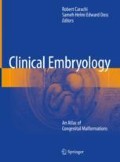Abstract
The word teratogenic is derived from the Greek teratos, meaning monster, and genesis, to be born or produced. A teratogenic agent is the one capable of causing birth defects following exposure during pregnancy. Substances with teratogenic qualities include drugs, environmental agents, infections, toxins and nutrients. The probability of a malformation being produced depends on the dose of the agent, the stage at which the embryo is exposed and the genotype of the embryo and the mother.
Access this chapter
Tax calculation will be finalised at checkout
Purchases are for personal use only
Further Reading
Beckwith JB. Congenital malformations: from superstition to understanding. Virchows Arch. 2012;461(6):609–19.
Coll O, Benoist G, Ville Y, Weisman LE, Botet F, Anceschi MM, et al. Guidelines on CMV congenital infection. J Perinat Med. 2009;37(5):433–45.
Detrait ER, George TM, Etchevers HC, Gilbert JR, Vekemans M, Speer MC. Human neural tube defects: developmental biology, epidemiology, and genetics. Neurotoxicol Teratol. 2005;27(3):515–24.
Gregg NM. Congenital cataract following German measles in the mother. Trans Ophthalmol Soc Austr. 1941;3:35–46.
Jones K, Smith D, Ulleland C, Streissguth A. Pattern of malformation in offspring of chronic alcoholic mothers. Lancet. 1973;301(7815):1267–71.
Lumley J, Watson L, Watson M, Bower C. Periconceptional supplementation with folate and/or multivitamins for preventing neural tube defects. Cochrane Database of Systematic Reviews. 2001;(3):CD001056. https://doi.org/10.1002/14651858.CD001056.
Muralidharan P, Sarmah S, Zhou FC, Marrs JA. Fetal alcohol spectrum disorder (FASD) associated neural defects: complex mechanisms and potential therapeutic targets. Brain Sci. 2013;3(2):964–91.
Newman CGH. The thalidomide syndrome: risks of exposure and spectrum of malformations. Clin Perinatol. 1986;13(3):555–73.
Smithells RW, Newman CGH. Recognition of thalidomide defects. J Med Genet. 1992;29(10):716–23.
Vargesson N. Thalidomide embryopathy: an enigmatic challenge. ISRN Dev Biol. 2013;2013:241016, 18 pages.
Vianna FS, Schuler-Faccini L, Leite JC, et al. Recognition of the phenotype of thalidomide embryopathy in countries endemic for leprosy: new cases and review of the main dysmorphological findings. Clin Dysmorphol. 2013;22:59–63.
Author information
Authors and Affiliations
Editor information
Editors and Affiliations
Rights and permissions
Copyright information
© 2019 Springer International Publishing AG, part of Springer Nature
About this chapter
Cite this chapter
Wills, S. (2019). Teratogenesis and Infection. In: Carachi, R., Doss, S. (eds) Clinical Embryology. Springer, Cham. https://doi.org/10.1007/978-3-319-26158-4_5
Download citation
DOI: https://doi.org/10.1007/978-3-319-26158-4_5
Published:
Publisher Name: Springer, Cham
Print ISBN: 978-3-319-26156-0
Online ISBN: 978-3-319-26158-4
eBook Packages: MedicineMedicine (R0)

